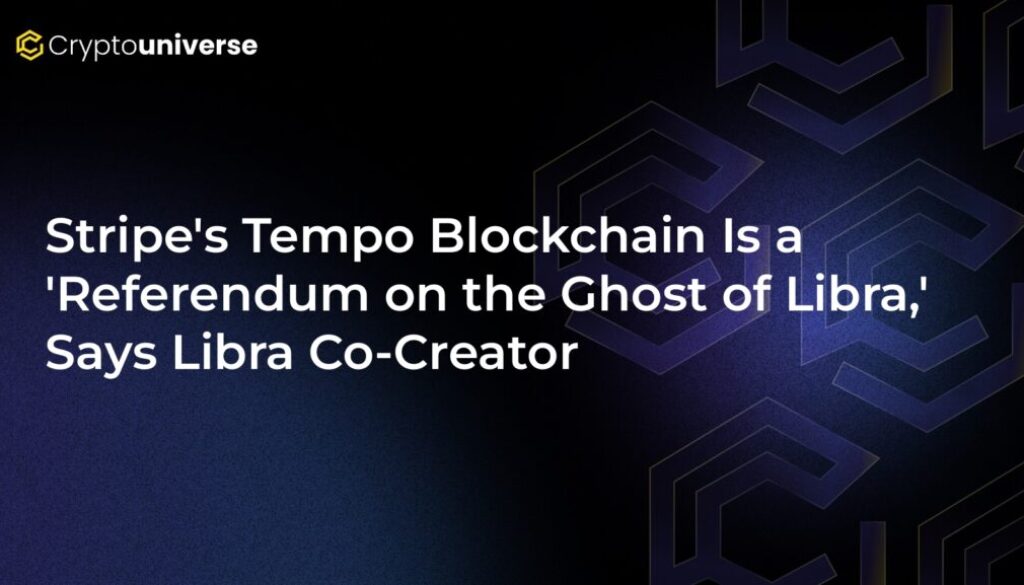Stripe’s Tempo Blockchain Is a ‘Referendum on the Ghost of Libra,’ Says Libra Co-Creator

The Ghost of Libra Haunts Crypto’s New Corporate Giants
The world of crypto payments is heating up, with fintech giants Stripe and Circle launching powerful new blockchains. But as they step into the spotlight, a warning from the past echoes through the industry. Christian Catalini, a co-creator of Facebook’s ambitious-yet-doomed Libra project, suggests that these new networks, while commercially promising, may be walking the same path that led Libra to compromise its core ideals.
In a powerful reflection, Catalini framed the launch of Stripe’s new blockchain perfectly, stating that
A Quick Recap: Why Did Facebook’s Libra (Diem) Fail?
Launched in 2019, Libra was Meta’s (then Facebook) audacious plan to create a global digital currency. The vision was simple yet revolutionary: make sending money as easy as sending a message. Backed by a basket of stable assets, Libra aimed to serve the unbanked and streamline international payments.
However, the project was met with immediate and intense backlash from regulators worldwide. Governments feared a private corporation controlling a global currency, citing risks to financial sovereignty, monetary policy, and user privacy. Despite rebranding to Diem in an effort to reset its image, the project couldn’t escape the regulatory pressure. By 2022, it was officially shuttered, its assets sold off.
The Original Sin: Sacrificing Decentralization at the Altar of Regulation
According to Catalini, who served as Libra’s chief economist, the project’s first major retreat was abandoning non-custodial wallets. In the world of crypto, a non-custodial wallet means you, and only you, control your funds. This is the essence of self-sovereignty.
Regulators, however, found this concept unmanageable. They were accustomed to a world of financial intermediaries—banks and institutions they could hold accountable. They needed a “clear perimeter” and a responsible party to contact (and penalize) if things went wrong. As Catalini put it, “For them, killing self-custody wasn’t a choice, it was an obvious necessity.”
This forced compromise revealed a stark lesson: “As long as there is a single throat to choke — or a committee of them — you can’t truly rewire the system.” Any network with a central architect, he warned, is living on borrowed time.
Enter the New Contenders: Stripe’s Tempo and Circle’s Arc
Fast forward to today, and two new, powerful blockchains are picking up where Libra left off. Both are designed specifically for payments and backed by major industry players.
Stripe’s Tempo: A High-Speed Payments Powerhouse
Unveiled by payments giant Stripe and crypto venture firm Paradigm, Tempo is a Layer-1 blockchain built for scale. Its key features include:
- Massive Throughput: Capable of handling over 100,000 transactions per second (TPS).
- EVM-Compatibility: Easily integrates with the existing Ethereum ecosystem.
- Stablecoin Gas Fees: Users can pay for transactions using any stablecoin, eliminating the need for volatile native tokens.
- Powerful Partners: Early design partners include Visa, Deutsche Bank, Shopify, OpenAI, and Revolut.
Circle’s Arc: A Network Built for USDC
Circle, the issuer of the USDC stablecoin, launched Arc as a Layer-1 network purpose-built for stablecoin finance. It offers:
- Predictable Costs: Uses USDC for gas fees, providing stable, dollar-denominated transaction costs.
- Built-in FX Engine: Designed to facilitate seamless cross-border payments.
- High Performance: Promises sub-second transaction finality.
- Enterprise Focus: Aims to support tokenized capital markets, on-chain credit, and programmable payments.
New Players, Same Game? The Centralization Dilemma
While Tempo and Arc represent significant technological advancements, Catalini warns they risk repeating Libra’s fundamental compromise. Instead of creating an open, borderless financial system, they could simply replace the old guards—banks and card networks—with a new set of dominant fintech players.
“The throne will have new occupants, but it will be the same throne,” he wrote, capturing the fear that we are just witnessing a changing of the guard, not a change in the system itself.
Adding a layer of irony to this story is the fact that Stripe was an original member of the Libra Association before pulling out amid the regulatory firestorm. Now, it’s back with its own version, arguably what Libra could have become.
The Final Referendum: Was Libra Just Too Early?
This brings us to the core of Catalini’s argument. The success or failure of Stripe’s Tempo will serve as a referendum on Libra’s legacy. If Tempo thrives where Libra failed, it might suggest that Libra’s core design wasn’t the problem—its timing was.
Perhaps the world wasn’t ready for a Facebook-led currency in 2019, but it may now be open to a similar vision from established financial players like Stripe and Circle. If so, it could signal a major shift in the crypto landscape, where the early, cypherpunk dream of open, permissionless money is overtaken by more pragmatic, centralized, and corporate-friendly solutions.
The battle for the future of money is far from over. Will it be decentralized and open, or efficient, permissioned, and controlled by a new set of financial empires? The fate of Tempo may give us the answer.


